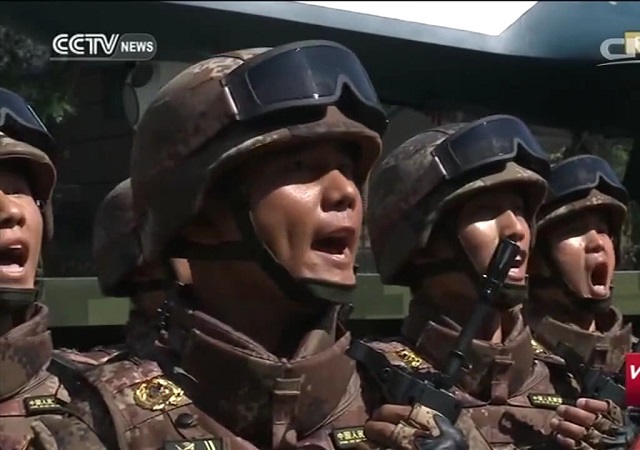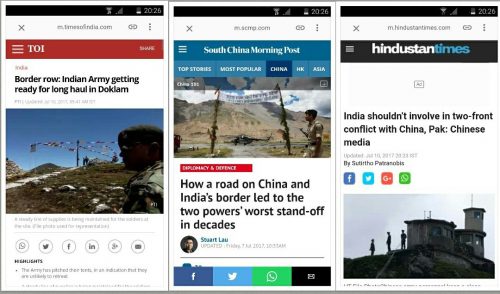Long-standing China-India Border Dispute Deepens
Military stand-off along the China-India border ‘most serious confrontation in more than 30 years,’ Chinese media reports

A territorial dispute along the China-India border is threatening to turn into a military conflict between the two nuclear-armed nations. The area under dispute is located near the ‘Bhutan tri-junction’, where the borders of China, India, and the tiny Buddhist Kingdom of Bhutan meet. The Chinese envoy to New Delhi described the latest standoff as “the most serious confrontation between the two nations in more than 30 years,” Chinese daily South China Morning reported.
China and India fought a war in 1962 over similar border disputes, which ended in a devastating defeat for India. Almost 55 years later, and two Asian giants continue facing off each other along a three thousand kilometre-long contested mountainous border.
New Delhi is taking a tough stance in this latest phase of escalation with the Indian army setting up supply lines leading to the site of the latest stand off and officials claiming that the “Indian Army is not going to wilt under any pressure from China,” to quote the newspaper Times of India:
The Indian soldiers deployed in the disputed area have pitched their tents, in an indication that they are unlikely to retreat unless there was reciprocity from China’s PLA personnel in ending the face-off at an altitude of around 10,000 feet in the Sikkim section (North Eastern part of India).
Amid growing border tensions, China has issued a travel advisory to its citizens travelling to India. New Delhi based business daily Economic Times reports:
Amid bilateral tensions over the Sikkim standoff, China today issued an advisory for its citizens travelling to India, asking them to take necessary precautions for their personal safety. “It is not a travel alert. It is an advisory asking Chinese travellers to be careful,” an official of the Chinese Foreign Ministry told [Indian news agency] PTI here.
Hong Kong-based South China Morning Post quoted officials in Beijing, saying that the current “border row” between the two countries was “the worst in 30 years.” The newspaper placed the blame for the mounting escalation squarely on the Indian-side, writing:
China’s envoy to India has warned that a military stand-off along a contested part of the border in the Himalayas was the most serious confrontation between the two nations in more than 30 years.
Ambassador Luo Zhaohui told media in New Delhi that the Chinese people were deeply angry over the “occupation” by Indian troops of its sovereign territory but said the showdown should be resolved through diplomatic means.
Faced with an increasingly hostile China, India is keen to forge strategic partnerships with Japan and other regional powers. Indian Prime Minister Modi’s desire to forge stronger strategic ties with the U.S. is in large part driven by the aggressive stance taken by China. This week, warships and aircraft from the U.S., Japan, and India will take part in a joint naval excesses near the Malabar Coast of India.
The current border dispute comes in the context of China’s massive naval and military build-up. China has ventured into international waters to build a string of artificial islands in the South China Sea to serve as military bases and landing strips. Communist China has ongoing border disputes with 18 of its neighbours.
Raw footage: Scuffle between Chinese and Indian soldiers (June 2017):
[Cover image via YouTube]
1962 War
“Tensions along parts of the 3,500 km frontier that China and India share have simmered ever since the two sides fought a brief but bloody war in 1962,” South China Morning Post added, referring to the 30-day China-India war along their vast Himalayan frontier at the height of the Cold War.
During the days of Kennedy presidency, as the Cuban Missile Crisis played out in October of 1962, China launched an all-out attack on Indian forces along India’s eastern Himalayan border.
Indian Prime Minister Jawaharlal Nehru’s socialist policies wreaked havoc on India’s economy and left the country’s military ill-prepared and ill-equipped for an armed conflict with their Communist neighbour. India’s Nehru, being a fervent Socialist, saw Mao’s China as an ideological ally. As the Chinese Army advanced deep inside the Indian border, Nehru-led Indian government admitted being ‘caught napping.’
At that crucial moment, President Kennedy came to India’s aid — despite Nehru’s hobnobbing with Moscow and Soviet client states — to halt the Chinese. Kennedy even dispatched a U.S. aircraft carrier battle group to the Bay of Bengal in an apparent attempt to put pressure on Communist China. The U.S. mobilisation was a major factor in convincing Chairman Mao to stop the Chinese offensive, bringing the war to a quick close.
Watch: President Kennedy and the China-India War of 1962 (Brookings Institute)
 DONATE
DONATE
Donations tax deductible
to the full extent allowed by law.









Comments
What has this got to do with the Trump-Russia collusion scandal? Can’t let extraneous news detract from the Big Story.
But who would believe the MSM? Let alone believe the Communist MSM.
Another lesson in how useful a carrier battle group can be.